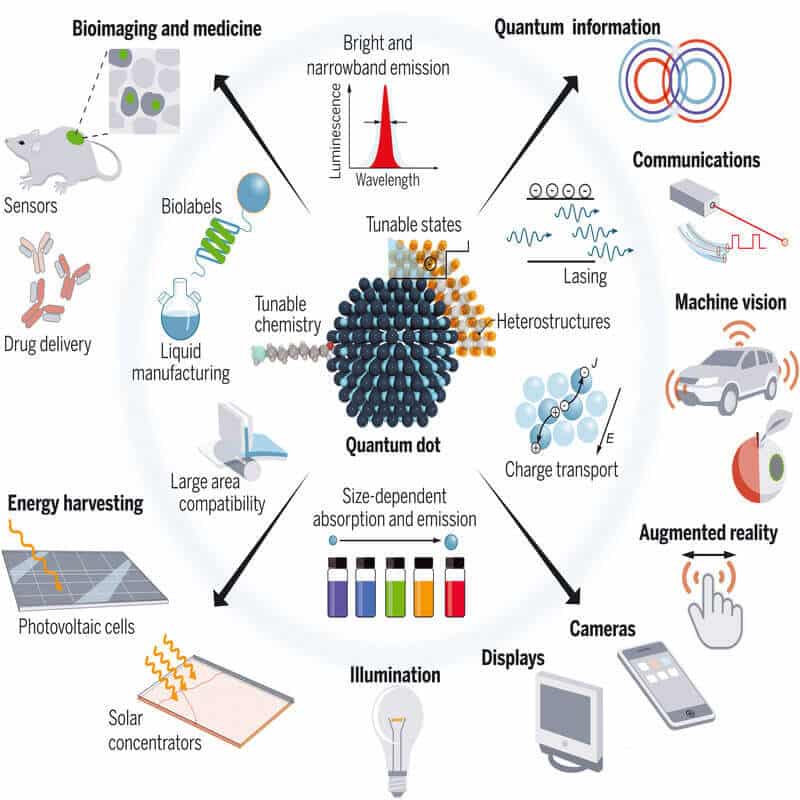
Quantum dots are nanoscale semiconductor particles with unique optical and electronic properties. The discovery of the particles fetched 2023’s Nobel prize in chemistry, hence it is important to learn about them. Read here to understand better.
The Nobel Prize in Chemistry 2023 recognizes the discovery and synthesis of nanometre-sized semiconductor crystals, the properties of which are determined by quantum size effects.
Referred to as quantum dots, such nanoparticles are so small that their physical size determines the quantum mechanical states of the material’s charge carriers.
What are Quantum dots?
Quantum dots (QDs) constitute a new class of materials that is neither molecular nor bulk. They have the same structure and atomic composition as bulk materials, but their properties can be tuned using a single parameter, the particle’s size.
- They are typically composed of materials like cadmium selenide (CdSe), cadmium telluride (CdTe), or indium arsenide (InAs) and have gained significant attention in various fields due to their size-dependent behavior and potential applications.
Some interesting properties of these particles are:
- Size-Dependent Properties: They are extremely small, with dimensions typically ranging from a few nanometers to tens of nanometers. Their optical and electronic properties, including the absorption and emission of light, are highly dependent on their size. This phenomenon is known as quantum confinement.
- Photoluminescence: They exhibit strong and tunable photoluminescence, meaning they can emit light of different colors (wavelengths) depending on their size. This property makes them valuable for applications in displays, lighting, and biological imaging.
- Narrow Emission Peaks: These particles have narrow emission peaks, resulting in highly saturated and pure colors. This characteristic is advantageous in display technologies where a wide color gamut is desired.
- Semiconductor Behavior: These behave like semiconductors, which means they can conduct electricity under certain conditions. This property opens up possibilities for their use in electronics and photodetectors.
Applications of quantum dots

- Display Technology: Quantum dots are used in quantum dot displays, also known as QLED (Quantum Dot Light Emitting Diode) displays. They enhance the color accuracy, brightness, and energy efficiency of displays compared to traditional LCD technology.
- Biological Imaging: They are employed as fluorescent probes in biological and medical imaging. Their small size and bright, tunable emissions make them useful for tracking cellular and molecular processes.
- Solar Cells: QDs have the potential to improve the efficiency of solar cells. Researchers are exploring their use in photovoltaics to capture a broader spectrum of light.
- LED Lighting: QDs are used in LED lighting to produce high-quality, energy-efficient white light. They can be used to generate warm or cool white light with excellent color rendering.
- Quantum Computing: QDs are being studied for their potential use in quantum computing due to their ability to trap and manipulate individual electrons and quantum states.
- Cancer Detection: QDs functionalized with targeting molecules can be used for cancer detection. They can selectively bind to cancer cells, aiding in early diagnosis.
Read: Nanotechnology in health
Concerns
Quantum dots often contain toxic materials like cadmium, which raises environmental and health concerns. Research is ongoing to develop safer quantum dot materials.
- Toxicity: Some types of quantum dots, particularly those containing heavy metals like cadmium and lead, can be toxic to living organisms, including humans. The release of these toxic materials into the environment or the human body can have adverse health effects.
- Environmental Impact: Quantum dots, especially those used in consumer electronics and displays, may contribute to electronic waste if not properly managed. E-waste contains hazardous materials, including quantum dots, which can leach into the environment if not disposed of responsibly.
- Health Risks: Quantum dots may pose health risks when used in medical applications. While they have potential in imaging and drug delivery, their long-term effects on the human body are not fully understood, and more research is needed to assess their safety.
- Manufacturing Challenges: The production of quantum dots can be complex and energy-intensive. The synthesis of quantum dots often requires the use of hazardous chemicals, and the manufacturing process may result in waste byproducts.
- Privacy Concerns: Quantum dots have been proposed for use in security and surveillance applications, including invisible ink and tracking technologies. These applications raise privacy concerns, as quantum dot-based tracking could be used for invasive surveillance.
- Regulatory Oversight: The regulatory framework for quantum dots and nanotechnology, in general, is still evolving. Ensuring proper safety assessments, labeling, and disposal guidelines is essential to mitigate potential risks.
- Ethical Considerations: As with any emerging technology, there are ethical considerations surrounding the use of quantum dots, especially in areas like surveillance and privacy. Ethical guidelines and discussions are necessary to navigate these issues.
- Commercial Interests: Quantum dots have attracted significant commercial interest, and there may be pressure to rush products to market without adequate safety testing. This could potentially lead to unforeseen consequences.
Nobel Prize in chemistry
The discovery of quantum dots, and the ability to synthesize such materials with high accuracy but relatively simple chemical methods, was an important step in the development of nanoscience and nanotechnology.
- The core principle of nanoscience is that at the scale of nanometres, materials, and particles attain new, size-dependent properties that can be harnessed and controlled for novel applications.
- The tools of chemistry are an indispensable enabler of nanotechnology, with applications in areas as diverse as biotechnology, catalysis, sensing, medical diagnostics, electronics, photonics, and quantum technology.
The research won the Nobel prize and was shared by three scientists:
- In the early 1980s, Alexei Ekimov succeeded in creating size-dependent quantum effects in colored glass. He demonstrated that the particle size affected the color of the glass via quantum effects.
- A few years later, Louis Brus was the first scientist in the world to prove size-dependent quantum effects in particles floating freely in a fluid.
- In 1993, Moungi Bawendi developed a technique to make quantum dots of well-defined sizes and with high optical quality
Conclusion
Quantum dots are nanoscale semiconductor particles with unique optical and electronic properties. Their size-dependent behavior and tunable emissions make them valuable in a wide range of applications, from display technology to medical imaging and beyond.
However, addressing environmental and health concerns associated with certain quantum dot materials is an important area of ongoing research and development.
Related articles: Quantum cryptography; Quantum Entanglement; National Quantum Mission
-Article by Swathi Satish






Leave a Reply